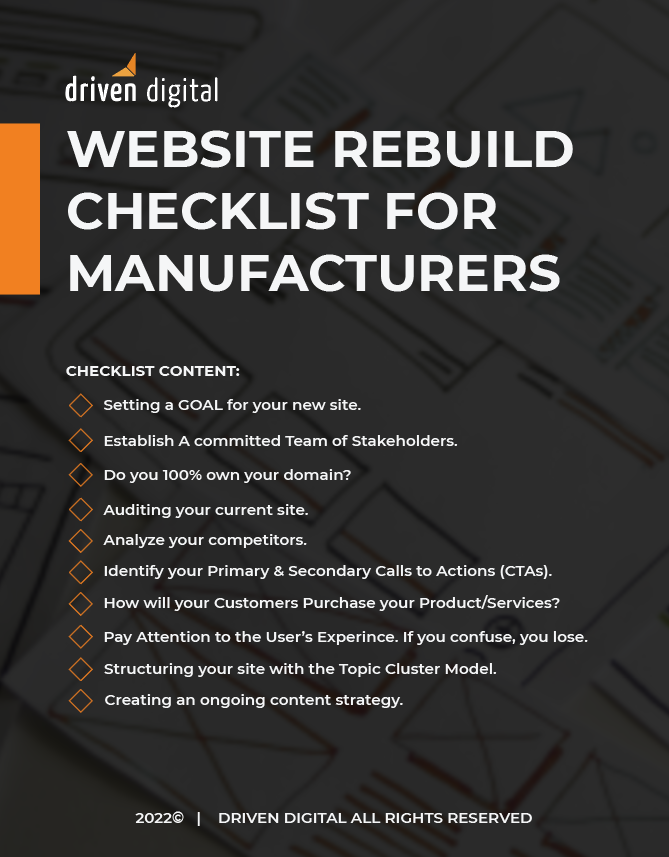Rebuilding your manufacturer website can seem daunting, we get it! Although, it doesn't have to be. We have a free and highly effective resource, a Website Rebuild Checklist for Manufacturers, that will help you successfully drive business and increase your revenue.
- Establish Website Goals
- Audit Your Current Website
- Analyze Your Competitor's Website
- Identify Calls-To-Actions (CTAs)
- Create An Ongoing Content Strategy

Why manufacturers should use a checklist when rebuilding their website
Using a checklist during a website redesign or rebuild is crucial for ensuring a smooth and successful process. Here are the key reasons why a checklist is important:
1. Organization and Efficiency: A website redesign involves numerous tasks and considerations. A checklist helps you stay organized by outlining all the necessary steps and elements that need attention. It ensures that no crucial aspect is overlooked and helps you track progress efficiently.
2. Comprehensive Approach: A checklist ensures that you cover all essential components of a website redesign. It includes technical, design, content, and SEO elements, among others. By following a checklist, you can ensure a holistic approach to the redesign process, resulting in a well-rounded and high-performing website.
3. Consistency and Quality Control: A checklist ensures consistency in design elements, branding, and user experience throughout the website. It helps you maintain a cohesive look and feel, ensuring that every page adheres to the defined standards. Additionally, a checklist enables quality control by providing a reference for reviewing and verifying completed tasks.
4. Time and Resource Management: A checklist helps in managing time and resources effectively. It allows you to allocate tasks to team members, set deadlines, and monitor progress. By following a checklist, you can streamline the website redesign process, prevent delays, and optimize resource utilization.
5. User Experience Optimization: A checklist prompts you to prioritize user experience enhancements during the redesign. It reminds you to consider factors such as mobile responsiveness, page load speed, intuitive navigation, and accessibility. By systematically addressing these aspects, you can create a website that offers an exceptional user experience.
6. SEO Considerations: A checklist ensures that you address important SEO elements during the redesign. It reminds you to update page titles, meta descriptions, URLs, and headings for optimal search engine visibility. By following SEO best practices outlined in the checklist, you can maintain or improve your website's rankings and organic traffic.
7. Testing and Launch Readiness: A checklist includes testing and launch preparation tasks. It prompts you to test the website thoroughly across different devices, browsers, and screen sizes to identify and fix any issues. The checklist also covers necessary steps to ensure a smooth launch, including setting up analytics, implementing tracking codes, and creating necessary backups.
By using a checklist, you can effectively manage the website redesign process, minimize errors, and deliver a high-quality website that meets your objectives and exceeds user expectations. It provides a systematic approach, keeps everyone on track, and ensures a successful outcome for your website redesign or rebuild project.